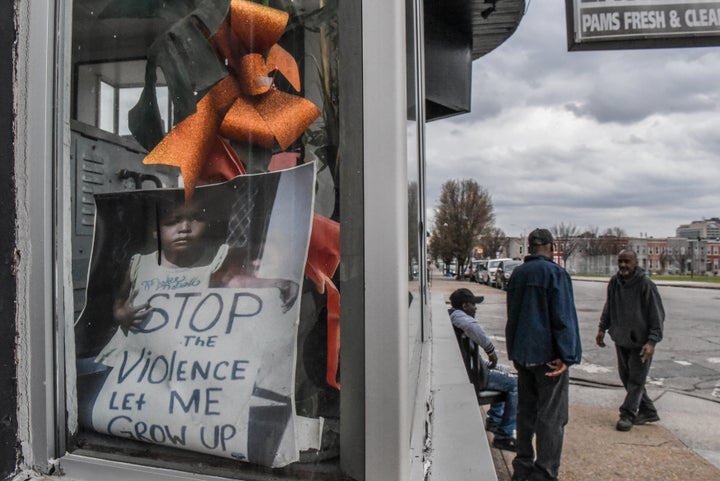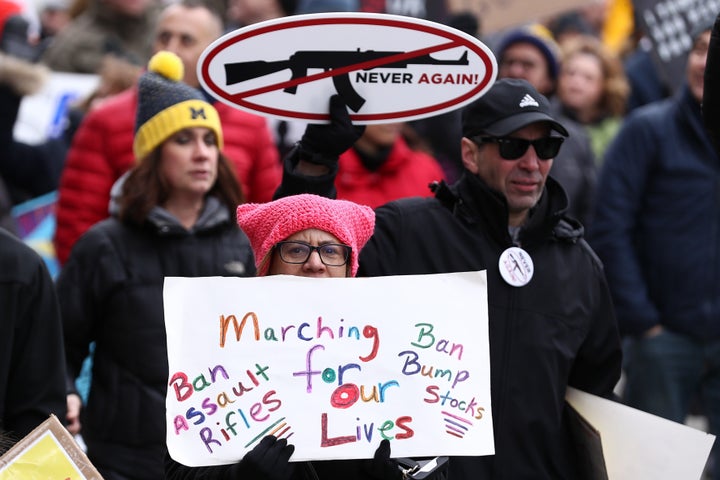
Maryland enacted a wide-reaching package of gun violence prevention laws last week, becoming one of just a handful of states to get behind little-known measures that could save hundreds of lives and millions of dollars.
The measure, the Public Safety and Violence Prevention Act of 2018, was designed to address urban violence, an issue that gets relatively little attention in the U.S. gun debate — it’s the mass shootings like Newtown, Las Vegas and Parkland that make the headlines — despite accounting for most of the 13,000 firearm homicides and 60,000 nonfatal shootings that take place across the nation each year.
The bill sets aside $5 million in the coming year to fund grants for programs that have been effective at making violence-stricken neighborhoods more peaceful.
Maryland is now one of just six states funding gun violence prevention and intervention programs. California, Connecticut, Illinois, Massachusetts and New York have been making modest investments for a number of years, and data suggest it has paid off in target cities, with substantial declines in shootings and violent crime, according to a recent report by the Giffords Law Center to Prevent Gun Violence, a national nonprofit founded by former Rep. Gabrielle Giffords (D-Ariz.).
The sponsor of the Maryland legislation, Democratic Delegate Brooke Lierman, said she felt compelled to act amid a murder epidemic in Baltimore, which saw more than 1,000 homicides from 2015 to 2017.
“What’s happening in Baltimore is a tragedy, as is what’s happening in other areas of the country where we are seeing homicide after homicide, death after death, day in and day out,” she told HuffPost. “Every dollar that we spend to prevent those deaths is definitely a dollar worth spending.”
Baltimore has already seen success with a prevention model called Cure Violence, a public health strategy that addresses the causes of violence. Case workers provide street outreach to those at risk of becoming victims or perpetrators of gun violence and mediate conflicts before they boil over. Neighborhoods that have adopted the program have seen far fewer shootings, with some recording periods of more than a year without a homicide, Lierman said.

Anti-violence advocates say contributing to these programs makes financial sense. Gun violence costs the U.S. an estimated $229 billion each year, according to a 2012 study that measured direct spending on law enforcement, criminal justice and health care as well as indirect costs like lost wages and the effects of shootings on victims’ quality of life.
Taxpayers often end up picking up a substantial portion of the tab for this violence. Many shooting victims don’t have private health insurance, and it’s expensive to prosecute and imprison perpetrators.
Previous studies have calculated that taxpayers shoulder an average of $464,000 in costs for each gun homicide and as much as $40,000 for each nonfatal shooting. In Maryland, gun violence costs taxpayers approximately $294 million every year, according to an estimate by Giffords based on those studies.
Supporters of this type of state-level initiative recognize that the problem of daily gun violence tends to be confined to cities, often to specific neighborhoods. But for people outside those areas, ignoring the issue comes at a cost too.
“Even if you live in a suburban neighborhood where gun violence isn’t affecting you day to day, you are directly paying for the gun violence in nearby cities,” said Mike McLively, the director of the Urban Gun Violence Initiative at Giffords. “If you can’t get on board for moral reasons, you should at least be able to get on board for economic reasons.”
But the fact that there has been so little support for and attention paid to prevention programs reveals a lot about the gun debate. Urban communities, particularly communities of color, face a shockingly disproportionate share of gun violence in the U.S.
Of the 13,000 victims of gun homicides in 2015, over 8,500 were men of color, according to the Giffords report. Black men account for nearly half of firearm homicide victims each year but make up only 6 percent of the population. This phenomenon, known as murder inequality, is one of the many racial disparities that plague urban neighborhoods in the form of poverty, lack of employment opportunity and disinvestment in education and social services.
Despite those figures, the mass shootings in affluent, predominantly white communities like Newtown, Connecticut, and Parkland, Florida, most frequently drive the conversation as well as the ensuing policy agenda on gun violence.
With those isolated tragedies in mind, it makes sense that some people support tightening gun laws and restricting access to certain weapons as a response. In communities like Newtown, where there hasn’t been a murder since the Sandy Hook Elementary School shooting in 2012, according to federal data, and Parkland, which hadn’t seen a gun homicide for at least a decade before the February shooting, a mass shooting may be residents’ only experience with gun violence.
There is disagreement over how effective certain popular gun control proposals would be at preventing mass shootings. But it seems unlikely that a measure like banning bump stocks would do much to stem the routine bloodshed in cities, where most lives are being lost.

This doesn’t mean state lawmakers shouldn’t continue to advocate for stronger gun laws as part of a comprehensive approach to preventing violence, said Lierman, who supported the complete package of firearms legislation in Maryland. But in states where gun politics is more contentious, she said, a plan like hers could give legislators a way to make a dent in violence without having to wade into a debate about gun control.
“It has absolutely nothing to do with taking away guns, and it should be exactly the kind of initiative that everybody, including gun enthusiasts, can support,” she said. “It is all about creating programs to stop gun violence.”
At a committee hearing for Lierman’s bill in February, pro-gun-rights lobbyists found reasons to oppose the effort.
The NRA would be “more comfortable if there were language included that recognizes the individual right to keep and bear arms,” a representative for the NRA’s Institute for Legislative Action said during testimony. She said the organization couldn’t commit to supporting the bill even if it were amended in that manner.
John Jocelyn of the NRA-affiliated Associated Gun Clubs of Baltimore criticized the legislation for placing too much focus on the issue of violence with firearms and not enough on issues like “rebuilding families.”
“The program in itself can’t succeed unless we address the foundation issues to begin with,” he said. He went on to encourage lawmakers to reintroduce the bill in a future session, when they could “address the entire massive problem we face.”
They were the lone opposing voices.
“I was disappointed but not surprised,” said Lierman. “The NRA has apparently decided it needs to oppose anything that has to do with decreasing gun violence.”
